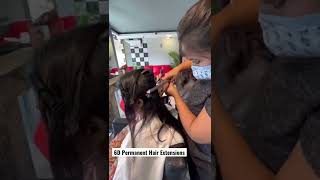Cover Your Grays With Henna And Indigo

Covering your gray is big business and for some of us, a major priority. There are a variety of reasons a woman might decide to cover her gray hair, for one having grays is a sign of getting old or being old.
I know, I know this is not across the board, after all gray is a trendy color this spring and summer but you must admit, just a few grays popping out is NOT the same thing and let’s not even get into how they are wiry and have a mind of their own, it just ain’t pretty.
I’ve never been one to cover my grays but in all honesty I don’t have a ton of them. I do color my hair and choose to use commercial brands like Shea Moisture* Hair Coloring System because they don’t have ammonia, parabens and sulfates but I know many naturals out here might prefer a natural alternative to regular hair color. With that said the best way to color your grays naturally would be to use Henna and Indigo*.
What is henna?
Henna is a tropical plant that grows in hot and dry climates of the Eastern hemisphere and is ground down into a powder and used by women for thousands of years to decorate the body. Henna is also quite popular as a natural way to dye hair for women and a great way to condition your strands as well.
Henna leaves are dried, ground and sifted into a powder and true henna* will stain the body and hair reddish brown. True henna will give a reddish, orange, light brownish color which indicative of the purest form of the powder. If you try henna and you see a different color then it’s not 100% henna and the product has something added to it.
Is it safe?
It’s perfectly safe if you are using 100% henna but many manufacturers are using low quality henna* promising colors outside of the typical reddish orange.
Many of the additives used in these low quality products can cause an allergic reaction to it’s users making those products virtually unsafe. The best thing to do is read the ingredients and make sure you are getting body art qualiy henna. If you want to purchase henna, and you want high quality henna you can get them from Mehandi.com and LUSH Cosmetics
Why do naturals use henna?
It’s pretty effective at covering grays and many Naturals use it for that reason or for conditioning their hair. Henna has also been used for changing their hair’s texture as some tout it loosens the curl pattern.
Loosening your curls is not set in stone, it really depends on the individual on how henna will affect your texture so use caution if altering your hair’s texture is an issue with you.
 What is indigo?
What is indigo?
Indigo powder is from the ground leaves of the indigo* plant which contains a deep blue dye used for centuries for textiles. It’s a part of the pea family and the leaves are harvested, dried, and ground into a powder for use in textiles, arts, and as a natural hair colorant.
Is it safe?
Just like henna it’s all natural and just like henna it can have additives added to it that may make it less safe to use.
Why do naturals use indigo?
Most times it’s in conjunction with Henna to create a darker color eliminating the red color that Henna* can give you. It was successfully used years ago as a way to dye hair but when synthetic products for dyeing became available the interest in using it died.
Both Henna and Indigo can be messy and it takes quite a few hours to change the grays but the results seem positive, true and most are happy after using them. We have two videos below from Kimmaytube as she shows us how she uses Henna along with Indigo to successfully hide her grays.
Henna on Natural Hair
Kim Love (Kimmaytube) shows her process of applying henna to her patch of grays in the front of her hair only. She does not use Henna as a conditioning agent and hasn’t seen any texture changes. We love how she breaks it down quite easily and quickly on what she does, how she does it and her way of keeping it as mess-free as possible. This is a time-consuming process so you might need to dedicate some time to it.
Henna On Natural Hair Part 2
Here’s part two with the indigo application. I really like this video because you get a recap of the entire process as well some options on how to get the indigo darker and what others may be mixing with Indigo* to achieve different colors. Again, it’s a time-consuming process.
Kim Love gives a great two part series explaining the process, great pics on how it looks before and after and why she uses it. She had amazing results on covering her grays and as always we must continue to arm ourselves with the proper knowledge of what we plan on using on our tresses to keep them healthy, happy, and gray hair free.
Have you tried Henna* and Indigo and if so what were your results?




